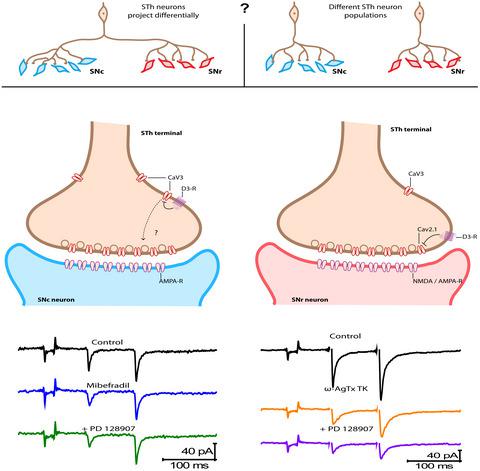Our official English website, www.x-mol.net, welcomes your
feedback! (Note: you will need to create a separate account there.)
Differential calcium channel-mediated dopaminergic modulation in the subthalamonigral synapse.
SYNAPSE ( IF 1.6 ) Pub Date : 2020-02-05 , DOI: 10.1002/syn.22149 Angel A Robles-Gómez 1 , Ana V Vega 2 , Benjamín Florán 3 , Jaime Barral 1
SYNAPSE ( IF 1.6 ) Pub Date : 2020-02-05 , DOI: 10.1002/syn.22149 Angel A Robles-Gómez 1 , Ana V Vega 2 , Benjamín Florán 3 , Jaime Barral 1
Affiliation

|
Dopamine (DA) modulates basal ganglia (BG) activity for initiation and execution of goal-directed movements and habits. While most studies are aimed to striatal function, the cellular and molecular mechanisms underlying dopaminergic regulation in other nuclei of the BG are not well understood. Therefore, we set to analyze the dopaminergic modulation occurring in subthalamo-nigral synapse, in both pars compacta (SNc) and pars reticulata (SNr) neurons, because these synapses are important for the integration of information previously processed in striatum and globus pallidus. In this study, electrophysiological and pharmacological evidence of dopaminergic modulation on glutamate release through calcium channels is presented. Using paired pulse ratio (PPR) measurements and selective blockers of these ionic channels, together with agonists and antagonists of DA D2 -like receptors, we found that blockade of the CaV 3 family occludes the presynaptic inhibition produced by the activation of DA receptors pharmacologically profiled as D3 -type in the STh-SNc synapses. On the contrast, the blockade of CaV 2 channels, but not CaV 3, occlude with the effect of the D3 agonist, PD 128907, in the STh-SNr synapse. The functional role of this differential distribution of calcium channels that modulate the release of glutamate in the SN implies a fine adjustment of firing for both classes of neurons. Dopaminergic neurons of the SNc establish a DA tone within the SN based on the excitatory/inhibitory inputs; such tone may contribute to processing information from subthalamic nucleus and could also be involved in pathological DA depletion that drives hyperexcitation of SNr neurons.
中文翻译:

丘脑下突触中差异钙通道介导的多巴胺能调节。
多巴胺 (DA) 调节基底神经节 (BG) 活动,以启动和执行目标导向的运动和习惯。虽然大多数研究都针对纹状体功能,但 BG 其他细胞核中多巴胺能调节的细胞和分子机制尚不清楚。因此,我们开始分析丘脑下-黑质突触中发生的多巴胺能调节,在致密部 (SNc) 和网状部 (SNr) 神经元中,因为这些突触对于先前在纹状体和苍白球中处理的信息的整合很重要。在这项研究中,提出了多巴胺能调节通过钙通道释放谷氨酸的电生理学和药理学证据。使用这些离子通道的配对脉冲比 (PPR) 测量和选择性阻断剂,与 DA D2 样受体的激动剂和拮抗剂一起,我们发现 CaV 3 家族的阻断阻断了由在 STh-SNc 突触中药理学描述为 D3 型的 DA 受体激活产生的突触前抑制。相比之下,在 STh-SNr 突触中,CaV 2 通道的阻断,而不是 CaV 3,在 D3 激动剂 PD 128907 的作用下被阻断。调节 SN 中谷氨酸盐释放的钙通道的这种差异分布的功能作用意味着对两类神经元的放电进行微调。SNc 的多巴胺能神经元根据兴奋性/抑制性输入在 SN 内建立 DA 音调;
更新日期:2020-02-05
中文翻译:

丘脑下突触中差异钙通道介导的多巴胺能调节。
多巴胺 (DA) 调节基底神经节 (BG) 活动,以启动和执行目标导向的运动和习惯。虽然大多数研究都针对纹状体功能,但 BG 其他细胞核中多巴胺能调节的细胞和分子机制尚不清楚。因此,我们开始分析丘脑下-黑质突触中发生的多巴胺能调节,在致密部 (SNc) 和网状部 (SNr) 神经元中,因为这些突触对于先前在纹状体和苍白球中处理的信息的整合很重要。在这项研究中,提出了多巴胺能调节通过钙通道释放谷氨酸的电生理学和药理学证据。使用这些离子通道的配对脉冲比 (PPR) 测量和选择性阻断剂,与 DA D2 样受体的激动剂和拮抗剂一起,我们发现 CaV 3 家族的阻断阻断了由在 STh-SNc 突触中药理学描述为 D3 型的 DA 受体激活产生的突触前抑制。相比之下,在 STh-SNr 突触中,CaV 2 通道的阻断,而不是 CaV 3,在 D3 激动剂 PD 128907 的作用下被阻断。调节 SN 中谷氨酸盐释放的钙通道的这种差异分布的功能作用意味着对两类神经元的放电进行微调。SNc 的多巴胺能神经元根据兴奋性/抑制性输入在 SN 内建立 DA 音调;











































 京公网安备 11010802027423号
京公网安备 11010802027423号